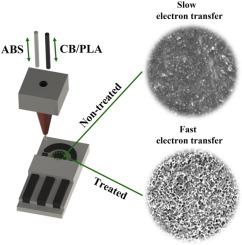Sensors and Actuators B: Chemical ( IF 8.4 ) Pub Date : 2021-09-15 , DOI: 10.1016/j.snb.2021.130721 Habdias A. Silva-Neto 1 , Murilo Santhiago 2, 3 , Lucas C. Duarte 1 , Wendell K.T. Coltro 1, 4

|
3D printing technologies have emerged as powerful tools for the development of electrochemical sensors. However, pre-treatment methods are often required to improve electrochemical properties of 3D printed sensing surface to enable higher electroanalytical performance. Herein, we report a toxic-free method for rapid activation of 3D printed electrochemical sensors. The proposed pre-treatment involves a combination of photochemical and electrochemical oxidation processes to degrade the excess of binder material impregnated on the cell surface. This strategy is simple, fast and exposes the carbon black nanoparticles to facilitate the faradaic reactions. The reported method ensured long-term stability (~2 months) and high heterogeneous rate constants (1.2 ± 0.3 × 10−3 cm s−1). In addition, peak currents were remarkably increased up to 353 ± 13%, clearly highlighting the potential use these 3D electrodes for electroanalytical applications. The treated electrode offered low detection limits (at µmol L−1 levels) for different analytes including metals like Cd(II) (0.009) and Pb(II) (0.006), midazolam maleate (0.54) and uric acid (0.71). Based on the achieved results, the activated, stable, and fully 3D printed electrochemical cell is very promising towards a plethora of high-performance electroanalytical applications.
中文翻译:

炭黑-热塑性混合材料的全 3D 打印和快速活化用于开发高度稳定的电化学传感器
3D 打印技术已成为开发电化学传感器的强大工具。然而,通常需要预处理方法来改善 3D 打印传感表面的电化学性能,以实现更高的电分析性能。在此,我们报告了一种快速激活 3D 打印电化学传感器的无毒方法。提议的预处理包括光化学和电化学氧化过程的组合,以降解浸渍在电池表面上的过量粘合剂材料。该策略简单、快速并且暴露炭黑纳米颗粒以促进法拉第反应。报告的方法确保了长期稳定性(~2 个月)和高异质速率常数(1.2 ± 0.3 × 10 -3 cm s -1)。此外,峰值电流显着增加至 353 ± 13%,清楚地突出了这些 3D 电极在电分析应用中的潜在用途。处理过的电极为不同分析物提供了低检测限(在 µmol L -1水平),包括金属,如 Cd(II) (0.009) 和 Pb(II) (0.006)、马来酸咪达唑仑 (0.54) 和尿酸 (0.71)。基于所取得的成果,活化、稳定且完全 3D 打印的电化学电池在众多高性能电分析应用中非常有前途。

























 京公网安备 11010802027423号
京公网安备 11010802027423号